How Was Being an Art in the Renaissance Financed
23 High Renaissance
The Loftier Renaissance was centered in Rome, and lasted from about 1490 to 1527, with the finish of the period marked by the Sack of Rome. Stylistically, painters during this period were influenced past classical art, and their works were harmonious. The restrained beauty of a Loftier Renaissance painting is created when all of the parts and details of the work support the cohesive whole. While earlier Renaissance artists would stress the perspective of a piece of work, or the technical aspects of a painting, Loftier Renaissance artists were willing to sacrifice technical principles in order to create a more beautiful, harmonious whole. The factors that contributed to the development of High Renaissance painting were twofold. Traditionally, Italian artists had painted in tempera paint. During the High Renaissance, artists began to use oil paints, which are easier to manipulate and allow the artist to create softer forms. Additionally, the number and diversity of patrons increased, which allowed for greater development in art.
The High Renaissance represents the culmination of the goals of the Early Renaissance, namely the realistic representation of figures in space rendered with credible motion and in an appropriately decorous style. The about well known artists from this stage are Leonardo da Vinci, Raphael, Titian, and Michelangelo. Their paintings and frescoes are among the about widely known works of art in the globe. Da Vinci'southward Last Supper, Raphael'due south The School of Athens and Michelangelo'due south Sistine Chapel Ceiling paintings are the masterpieces of this period and embody the elements of the Loftier Renaissance.

Painting in the High Renaissance
The 16th century (1500'south) is considered to be the high indicate in the development of Renaissance fine art. Nosotros look mainly at iii figures from this catamenia: Leonardo da Vinci, Raphael, and Michelangelo. This is the moment when artists begin to be recognized for their skill and sought after appropriately. The term "genius" is used for these figures. Giorgio Vasari, in maybe the start art history text, Lives of the Most Excellent Painters, Sculptors, and Architects, allies the talents of artists similar Michelangelo with the Divine – literally, touched past God.
Leonardo Da Vinci
Leonardo was the oldest of the iii. Born in the Tuscan boondocks of Vinci – Italian artists are often chosen afterwards their place of origin – he was apprenticed at 14 to the Florentine artist Verrochio. This was 1 of the nearly successful studiolos in Florence with the Medicis as patrons among others. Perugino and Botticelli were also associated with Verrocchio's studio.ii Leonardo painted very few actual paintings in his lifetime. He made money inventing weapons, waterworks and other things for wealthy condotierri and others as his many notebooks adjure. His paintings were, even so, of such a unique quality that they are revered today.
His Madonna of the Rocks, from 1491 – 99, and 1506 – 08, shows his skill with glazes of oil paint and manipulation of light to create the sfumato, or smoky softness, of the edges of things.
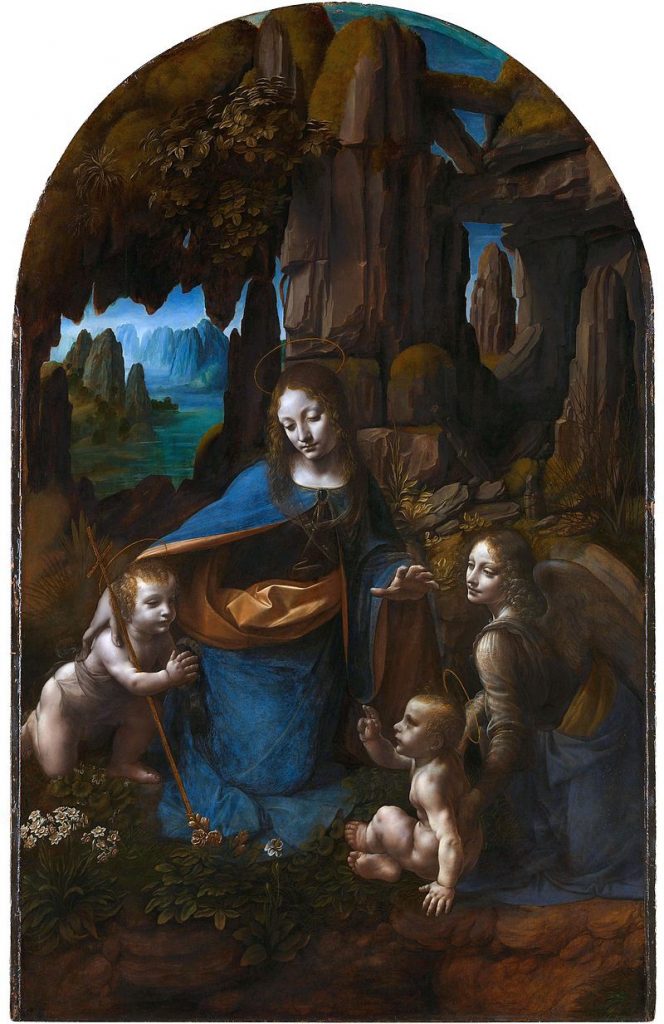
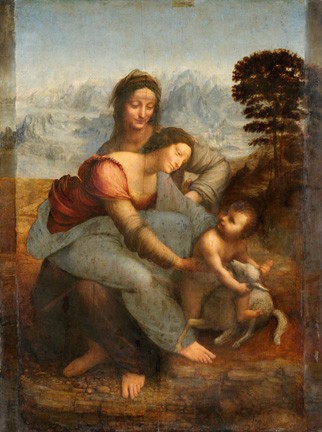
The Madonna and Kid with St. Anne uses the compositional device of the triangle to adapt the figures of a grown adult female on some other's lap in a typically Renaissance rational, geometric arrangement.
The Last Supper
Da Vinci'south most celebrated painting of the 1490s is The Last Supper, which was painted for the refectory of the Convent of Santa Maria della Grazie in Milan. The painting depicts the last meal shared by Jesus and the 12 Apostles where he announces that one of them will beguile him. When finished, the painting was acclaimed equally a masterpiece of design. This piece of work demonstrates something that da Vinci did very well: taking a very traditional subject matter, such as the Concluding Supper, and completely re-inventing information technology.
Prior to this moment in fine art history, every representation of the Terminal Supper followed the aforementioned visual tradition: Jesus and the Apostles seated at a table. Judas is placed on the contrary side of the table of anybody else and is effortlessly identified by the viewer. When da Vinci painted The Last Supper he placed Judas on the same side of the table as Christ and the Apostles, who are shown reacting to Jesus as he announces that ane of them will betray him. They are depicted as alarmed, upset, and trying to determine who will commit the act. The viewer also has to decide which effigy is Judas, who volition beguile Christ. Past depicting the scene in this manner, da Vinci has infused psychology into the work.
Unfortunately, this masterpiece of the Renaissance began to deteriorate immediately subsequently da Vinci finished painting, due largely to the painting technique that he had chosen. Instead of using the technique of fresco, da Vinci had used tempera over a basis that was mainly gesso in an effort to bring the subtle effects of oil paint to fresco. His new technique was not successful, and resulted in a surface that was subject to mold and flaking.
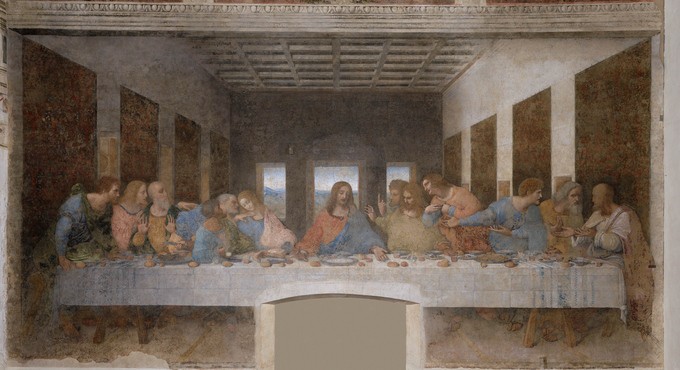
Where exercise the orthogonals lead in the one-point linear perspective in this painting?
Mona Lisa
Amongst the works created by da Vinci in the 16th century is the small portrait known as the Mona Lisa, or La Gioconda, married woman of Francesco del Giocondo who commissioned the painting (but never got it). In the nowadays era information technology is arguably the about famous painting in the globe. Its fame rests, in item, on the elusive smile on the woman's face up—its mysterious quality brought about perhaps by the fact that the artist has subtly shadowed the corners of the mouth and eyes so that the exact nature of the grinning cannot be determined.
The shadowy quality for which the work is renowned came to be called sfumato, the application of subtle layers or "glazes" of translucent paint so that there is no visible transition between colors, tones, and frequently objects. Other characteristics found in this work are the unadorned dress, in which the eyes and easily have no competition from other details; the dramatic landscape background, in which the world seems to be in a land of flux; the subdued coloring; and the extremely smooth nature of the painterly technique, employing oils, just practical much like tempera and blended on the surface so that the brushstrokes are indistinguishable. And again, da Vinci is innovating upon a type of painting here. Portraits were very mutual in the Renaissance. However, portraits of women were always in profile, which was seen equally proper and modest. Hither, da Vinci nowadays a portrait of a adult female who non simply faces the viewer but follows them with her eyes.
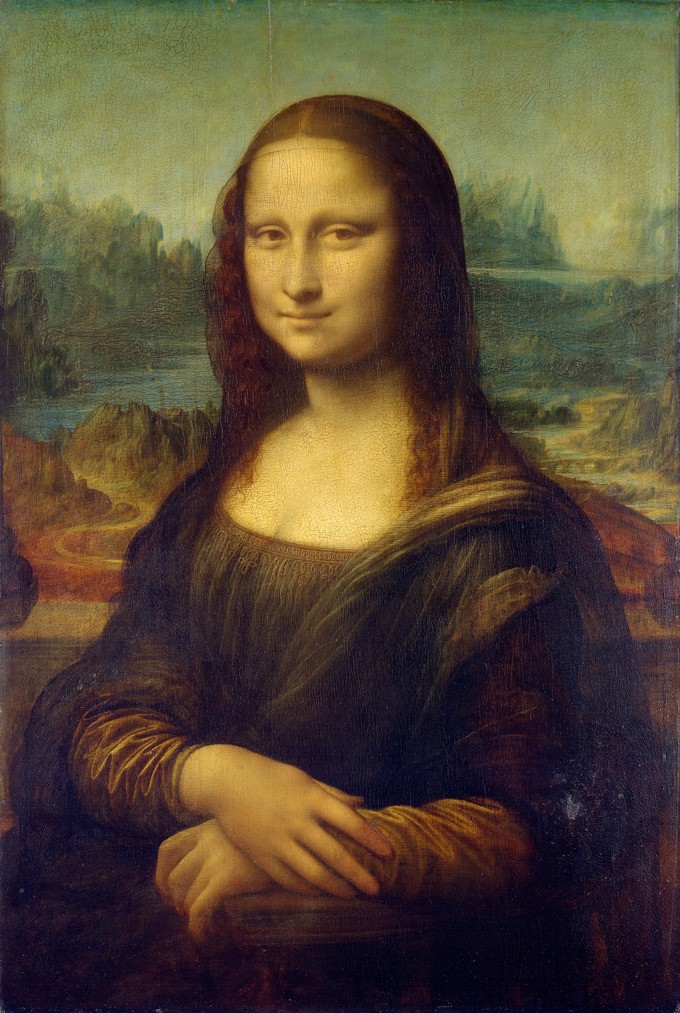
Sculpture in the High Renaissance
Sculpture in the Loftier Renaissance demonstrates the influence of classical antiquity and platonic naturalism.
During the Renaissance, an creative person was not just a painter, or an architect, or a sculptor. They were typically all 3. As a event, nosotros run into the same prominent names producing sculpture and the smashing Renaissance paintings. Additionally, the themes and goals of Loftier Renaissance sculpture are very much the same as High Renaissance painting. Sculptors during the Loftier Renaissance were deliberately quoting classical precedents and they aimed for ideal naturalism in their works. Michelangelo (1475–1564) is the prime example of a sculptor during the Renaissance; his works best demonstrate the goals and ideals of the High Renaissance sculptor.
Michelangelo
Bacchus
The Bacchus is Michelangelo'southward first recorded commission in Rome. The work is made of marble, it is life sized, and it is carved in the round. The sculpture is of the god of wine, who is holding a loving cup and appears boozer. The references to classical artifact are articulate in the subject thing, and the body of the god is based on the Apollo Belvedere, which Michelangelo would take seen while in Rome. Not only is the subject matter influenced by antiquity, just so are the artistic influences.
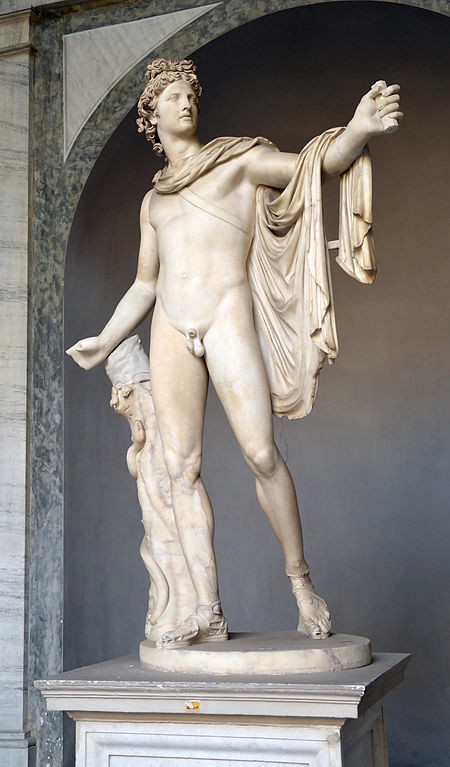
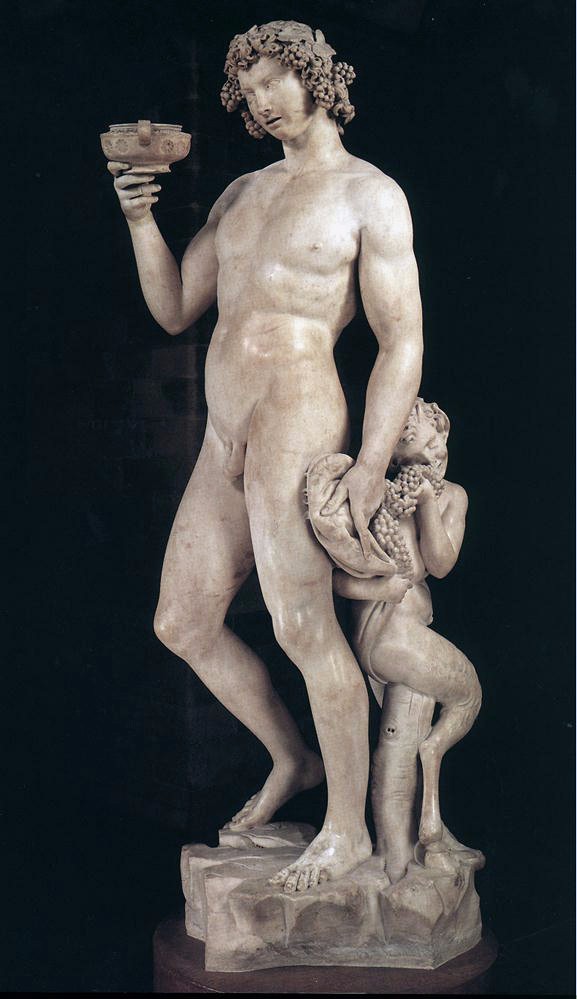
Pieta
While the Pieta is non based on classical antiquity in subject affair, the forms display the restrained beauty and ideal naturalism that was influenced by classical sculpture. Commissioned by a French Key for his tomb in Sometime St. Peter's, it is the work that fabricated Michelangelo'due south reputation. The subject area matter of the Virgin cradling Christ later the crucifixion was uncommon in the Italian Renaissance, indicating that it was chosen by the patron.
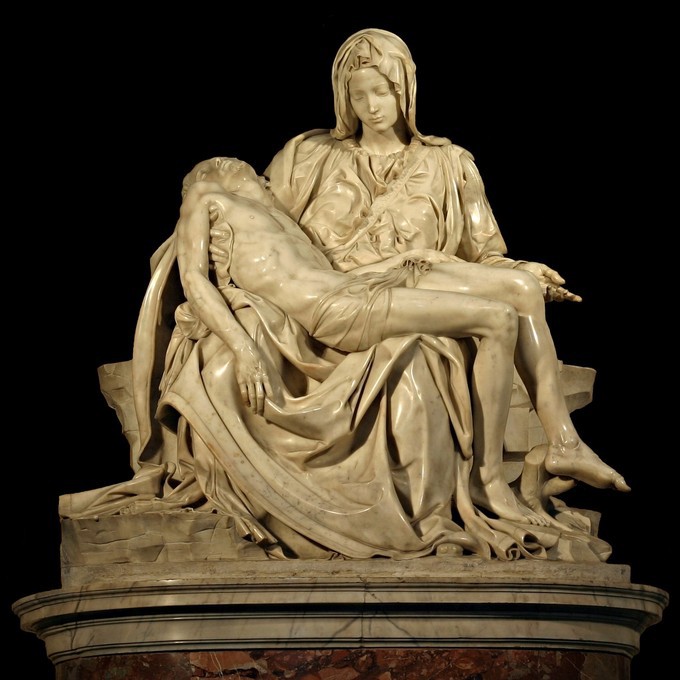
David
When the David was completed, it was intended to exist sit on the roofline of the Florentine Cathedral. But Florentines during that time recognized information technology as so special and beautiful that they actually had a coming together near where to place the sculpture. Members of the group that met included the artists Leonardo da Vinci and Botticelli. What about this work fabricated information technology stand out so spectacularly to Michelangelo's peers? The piece of work demonstrates classical influence. The work is nude, in emulation of Greek and Roman sculptures, and the David stands in a contrapposto pose. He shows restrained dazzler and ideal naturalism. Additionally, the work demonstrates an involvement in psychology, which was new to the High Renaissance, as Michelangelo depicts David concentrating in the moments before he takes down the behemothic. The subject matter was also very special to Florence as David was traditionally a borough symbol. The piece of work was ultimately placed in the Palazzo Vecchio and remains the prime number example of High Renaissance sculpture.
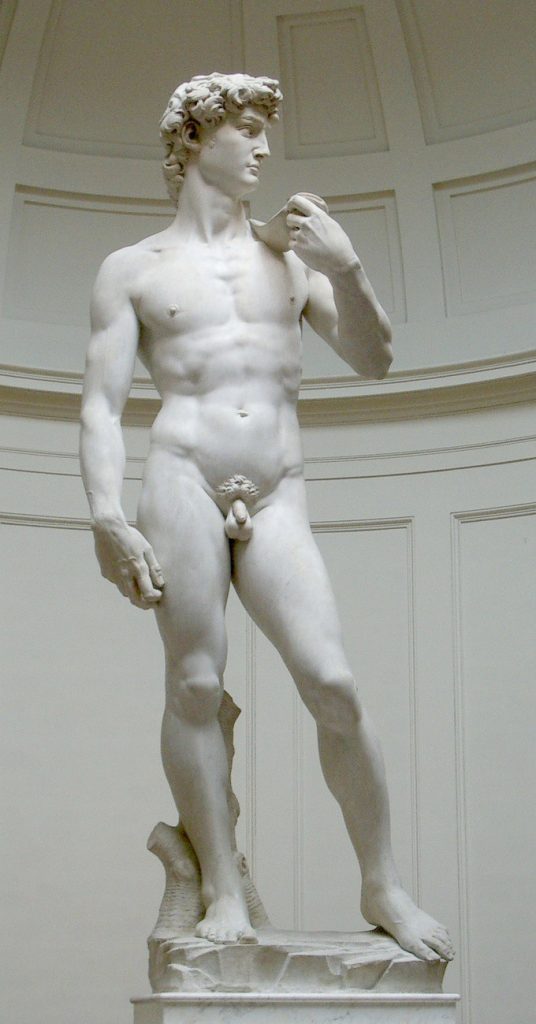
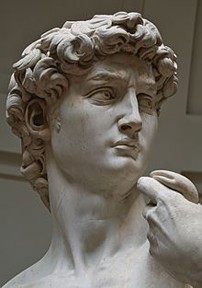
David by Michelangelo, c.1504: This work by Michelangelo remains the prime example of Loftier Renaissance sculpture. Item CC Past-SA iii.0 Jorg Bittner Unna
Michelangelo believed sculpture to be the purest, highest form of art. Nevertheless, he is just too-known for the fresco paintings he did for a number of popes. In 1508 Pope Julius II asked Michelangelo to paint the ceiling of the Sistine Ceiling in the Vatican. He offered him the hazard to do all the sculpture on his, Julius', tomb in render. Reluctantly, Michelangelo agreed and created 1 of the most iconic ready of images in the Western canon.
The program is fatigued from the Old Testament, but as in much of Christian imagery it prefigures the New. Prophets and Sibyls line the ceiling foretelling the coming of the Christian Messiah. Stories, like that of Jonah and the Whale (dead for 3 days and then alive again) prefigure the Resurrection. Down the center Michelangelo has created individual frames with the stories from Genesis – God creating Adam is maybe the best-known. Michelangelo creates heroic Classical male bodies that suggest the sculpture he would rather have been making. Dividing each frame and perched on plinths are male youths called "ignudi" whose purpose is not clear. For a basic introduction to the Sistine Ceiling from the Khan Academy see:
Raphael
Raphael Sanza was an Italian Renaissance painter and architect whose work is admired for its clarity of form and ease of limerick.
- Together with Michelangelo and Leonardo da Vinci, Raphael forms the traditional trinity of swell masters of the High Renaissance. He was enormously productive, running an unusually big workshop, and despite his death at thirty, he had a large body of piece of work.
- Some of Raphael's most striking artistic influences come from the paintings of Leonardo da Vinci; because of this inspiration, Raphael gave his figures more than dynamic and complex positions in his before compositions.
- Raphael's "Stanze" masterpieces are very large and complex compositions that have been regarded amidst the supreme works of the High Renaissance. They requite a highly arcadian delineation of the forms represented, and the compositions, though very carefully conceived in drawings, accomplish sprezzatura, the fine art of performing a job then gracefully it looks effortless.
- sprezzatura: The art of performing a difficult task then gracefully that information technology looks effortless.
- loggia: A roofed, open gallery.
- contrapposto: The position of a figure whose hips and legs are twisted away from the direction of the head and shoulders.
Overview
Raphael (1483–1520) was an Italian painter and architect of the Loftier Renaissance. His work is admired for its clarity of course and ease of composition and for its visual achievement of the Neoplatonic ideal of human grandeur. Together with Michelangelo and Leonardo da Vinci, Raphael forms the traditional trinity of cracking masters of that period. He was enormously productive, running an unusually large workshop; despite his death at xxx, a large trunk of his work remains among the most famous of High Renaissance art.
Influences
Some of Raphael'southward near striking artistic influences come from the paintings of Leonardo da Vinci. In response to da Vinci's work, in some of Raphael's earlier compositions he gave his figures more dynamic and complex positions. For example, Raphael's Saint Catherine of Alexandria (1507) borrows from the contrapposto pose of da Vinci's Leda and the Swans. Note the white wing of the swan as it folds effectually Leda'due south body.
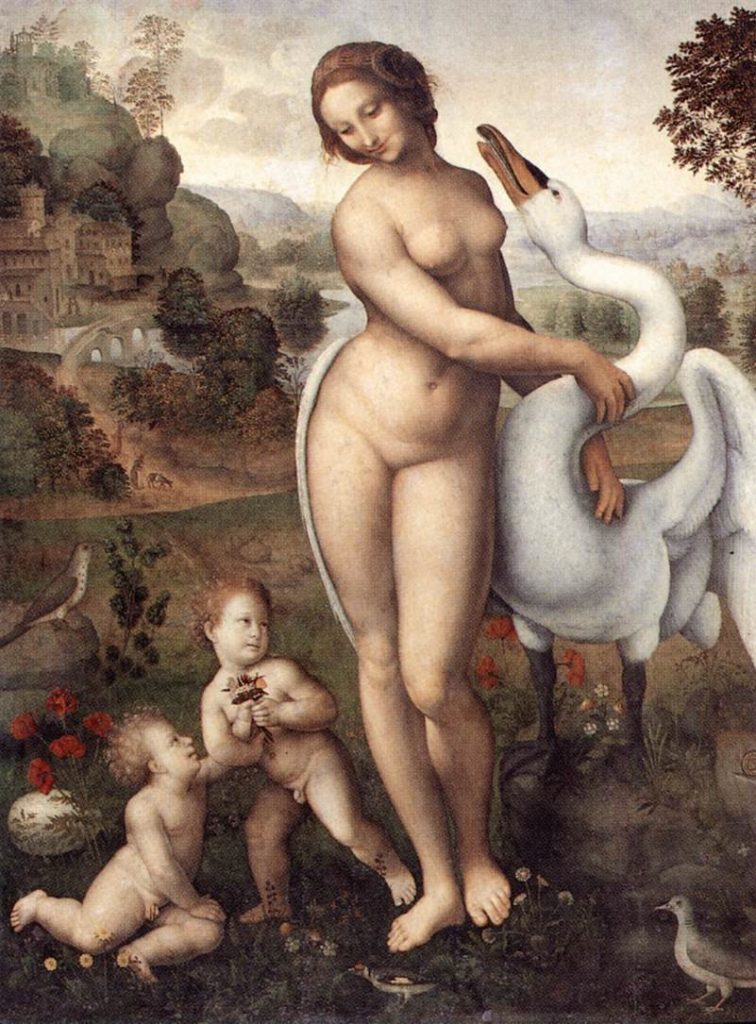
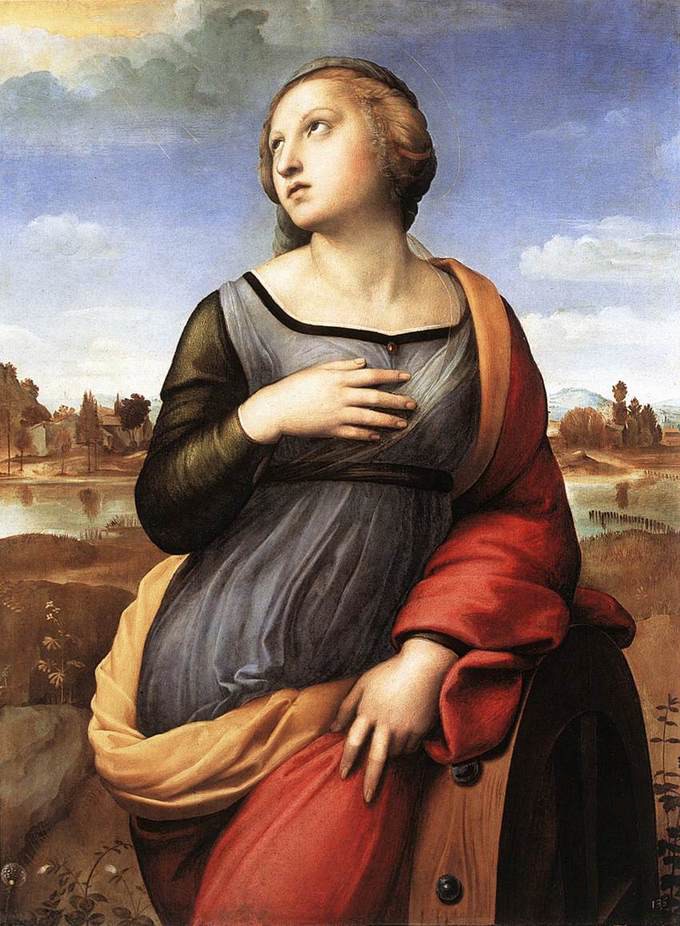
While Raphael was also aware of Michelangelo's works, he deviates from his style. In his Deposition of Christ, Raphael draws on classical sarcophagi to spread the figures across the front of the moving-picture show space in a complex and not wholly successful arrangement.
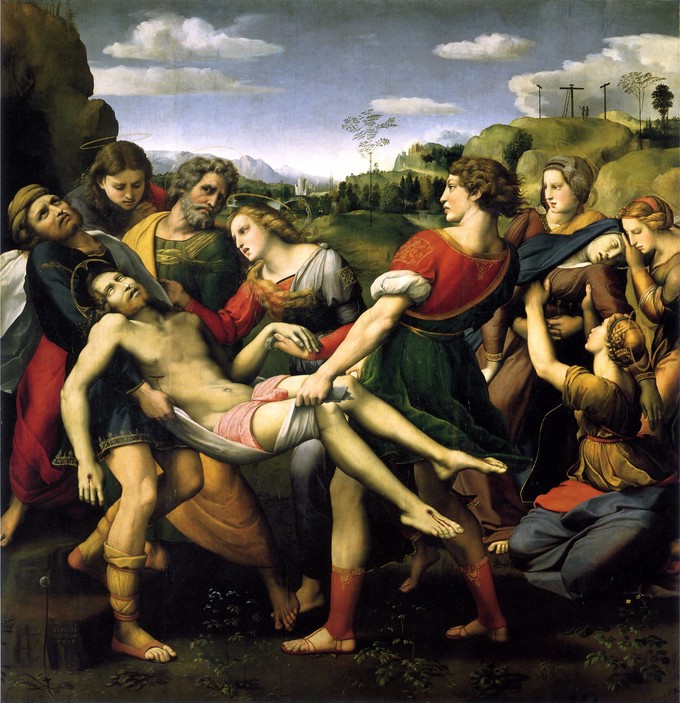
The Stanze Rooms and the Loggia
In 1511, Raphael began work on the famous Stanze paintings, which made a stunning bear on on Roman art, and are more often than not regarded equally his greatest masterpieces. The Stanza della Segnatura contains The School of Athens, Poetry, Disputa , and Police force. The Schoolhouse of Athens, depicting Plato and Aristotle, is one of his best known works. These very large and circuitous compositions have been regarded e'er since as amidst the supreme works of the High Renaissance, and the "classic art" of the post-antique Due west. They give a highly idealized depiction of the forms represented, and the compositions—though very carefully conceived in drawings— achieve sprezzatura, a term invented by Raphael's friend Castiglione, who defined it every bit "a certain nonchalance that conceals all artistry and makes whatever one says or does seem uncontrived and effortless."
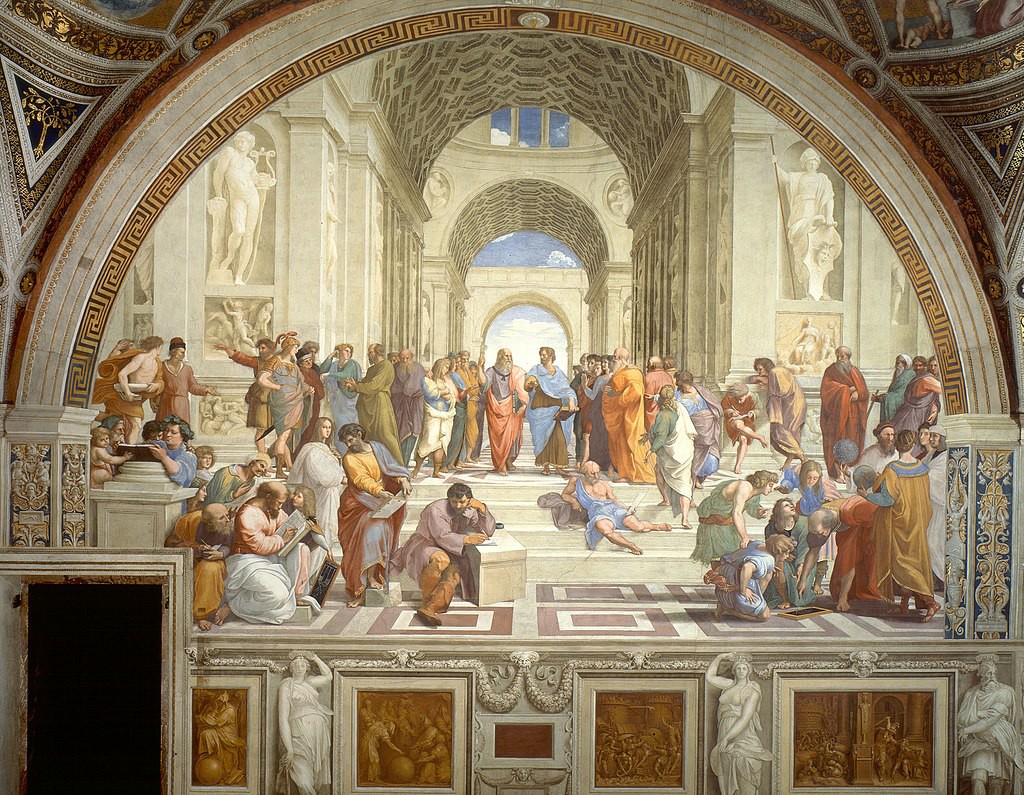
View of the Stanze della Segnatura, frescoes painted by Raphael
In the afterward stage of Raphael's career, he designed and painted the Loggia at the Vatican, a long thin gallery that was open up to a courtyard on one side and decorated with Roman fashion grottos, or cave-like garden ornaments. He likewise produced a number of significant altarpieces, including The Ecstasy of St. Cecilia and the Sistine Madonna. His final work, on which he was working until his death, was a large Transfiguration which, together with Il Spasimo (Christ Falling on the Fashion to Calvary), shows the direction his art was taking in his concluding years, becoming more proto-Baroque than Mannerist.
The Master'south studio
Raphael ran a workshop of over 50 pupils and assistants, many of whom later became pregnant artists in their ain correct. This was arguably the largest workshop squad assembled nether any unmarried old principal painter, and much higher than the norm. They included established masters from other parts of Italy, probably working with their own teams equally sub-contractors, equally well equally pupils and journeymen.
Draftsman
Raphael was one of the finest draftsmen in the history of Western art, and used drawings extensively to program his compositions. According to a near-gimmicky, when beginning to programme a limerick, he would lay out a large number of his stock drawings on the floor, and begin to depict "rapidly," borrowing figures from here and there. Over forty sketches survive for the Disputa in the Stanze, and there may well take been many more originally (over 400 sheets survived birthday).
As evidenced in his sketches for the Madonna and Kid, Raphael used unlike drawings to refine his poses and compositions, manifestly to a greater extent than near other painters. Well-nigh of Raphael'south drawings are rather precise—even initial sketches with naked outline figures are carefully drawn, and later drawings often accept a loftier degree of cease, with shading and sometimes highlights in white. They lack the freedom and energy of some of da Vinci'due south and Michelangelo'southward sketches, but are well-nigh always very satisfying aesthetically.
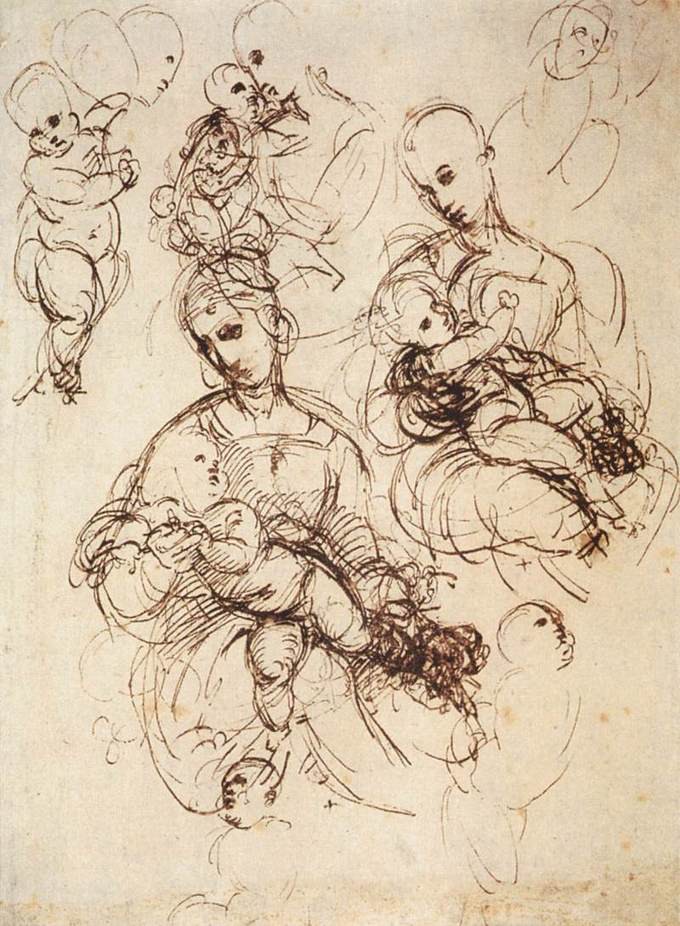
Renaissance Architecture in Florence
Renaissance architecture kickoff developed in Florence in the 15th century and represented a conscious revival of classical styles.
- The Renaissance mode of compages emerged in Florence not equally a ho-hum evolution from preceding styles, simply rather as a conscious development put into movement by architects seeking to revive the golden age of classical antiquity.
- The Renaissance style eschewed the complex proportional systems and irregular profiles of Gothic structures, and placed emphasis on symmetry, proportion, geometry, and regularity of parts.
- 15th century architecture in Florence featured the utilize of classical elements such every bit orderly arrangements of columns, pilasters, lintels, semicircular arches, and hemispherical domes.
- Filippo Brunelleschi was the first to develop a true Renaissance compages.
- While the enormous brick dome that covers the central space of the Florence Cathedral used Gothic technology, it was the first dome erected since classical Rome and became a ubiquitous characteristic in Renaissance churches.
- The buildings of the early Renaissance in Florence expressed a new sense of light, clarity, and spaciousness that reflected the enlightenment and clarity of mind glorified past the philosophy of Humanism.
- quattrocento: Term that denotes the 1400s, which may also be referred to every bit the 15th century Renaissance Italian menstruum.
- entablature: The office of a classical temple to a higher place the capitals of the columns; includes the architrave, frieze, and cornice but not the roof.
- pilaster: A rectangular column that projects partially from the wall to which information technology is fastened; it gives the appearance of a support, but is only for decoration.
The Quattrocento, or the 15th century in Florence, was marked by the development of the Renaissance way of architecture, which represented a conscious revival and evolution of ancient Greek and Roman architectural elements. The rules of Renaissance architecture were starting time formulated and put into do in 15th century Florence, whose buildings subsequently served as an inspiration to architects throughout Italy and Western Europe.
The Renaissance fashion of architecture emerged in Florence non equally a tedious evolution from preceding styles, only rather every bit a conscious development put into motility past architects seeking to revive a aureate historic period. These architects were sponsored by wealthy patrons including the powerful Medici family and the Silk Order, and approached their craft from an organized and scholarly perspective that coincided with a general revival of classical learning. The Renaissance style deliberately eschewed the complex proportional systems and irregular profiles of Gothic structures. Instead, Renaissance architects placed emphasis on symmetry, proportion, geometry, and regularity of parts as demonstrated in classical Roman architecture. They also made considerable use of classical antiquarian features such as orderly arrangements of columns, pilasters, lintels, semicircular arches, and hemispherical domes.
The person generally credited with originating the Renaissance way of architecture is Filippo Brunelleschi (1377–1446), whose first major committee—the enormous brick dome that covers the primal space of the Florence Cathedral—was also perhaps architecturally the most significant. Known equally the Duomo, the dome was engineered by Brunelleschi to cover a spanning in the already existing Cathedral. The dome retains the Gothic pointed arch and the Gothic ribs in its blueprint. The dome is structurally influenced past the groovy domes of Aboriginal Rome such as the Pantheon, and information technology is often described as the showtime building of the Renaissance. The dome is fabricated of cherry-red brick and was ingeniously constructed without supports, using a deep agreement of the laws of physics and mathematics. It remains the largest masonry dome in the world and was such an unprecedented success at its time that the dome became an indispensable element in church and even secular architecture thereafter. Khan Academy gives a expert, cursory overview of what information technology took for Brunelleschi to create the dome on the Florence Cathedral:
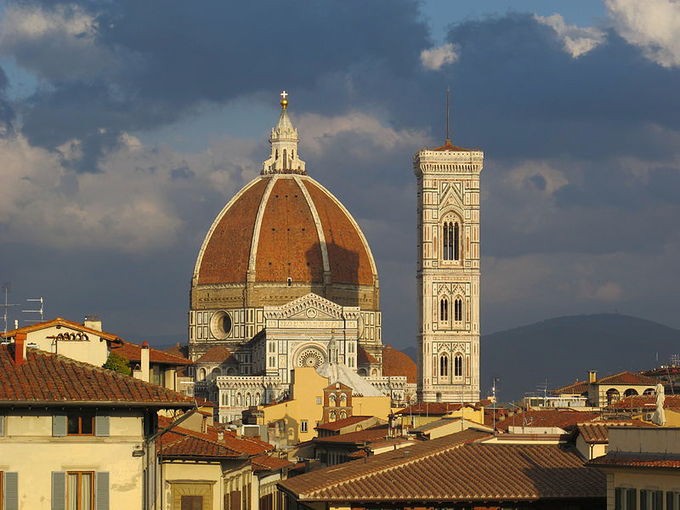
Another key effigy in the development of Renaissance architecture in Florence was Leon Battista Alberti (1402—1472), an important Humanist theoretician and designer, whose book on architecture De re aedificatoria was the first architectural treatise of the Renaissance. Alberti designed ii of Florence'southward best known 15th century buildings: the Palazzo Rucellai and the facade of the church of Santa Maria Novella. The Palazzo Rucellai, a palatial townhouse built 1446–51, typified the newly developing features of Renaissance architecture, including a classical ordering of columns over three levels and the use of pilasters and entablatures in proportional relationship to each other.
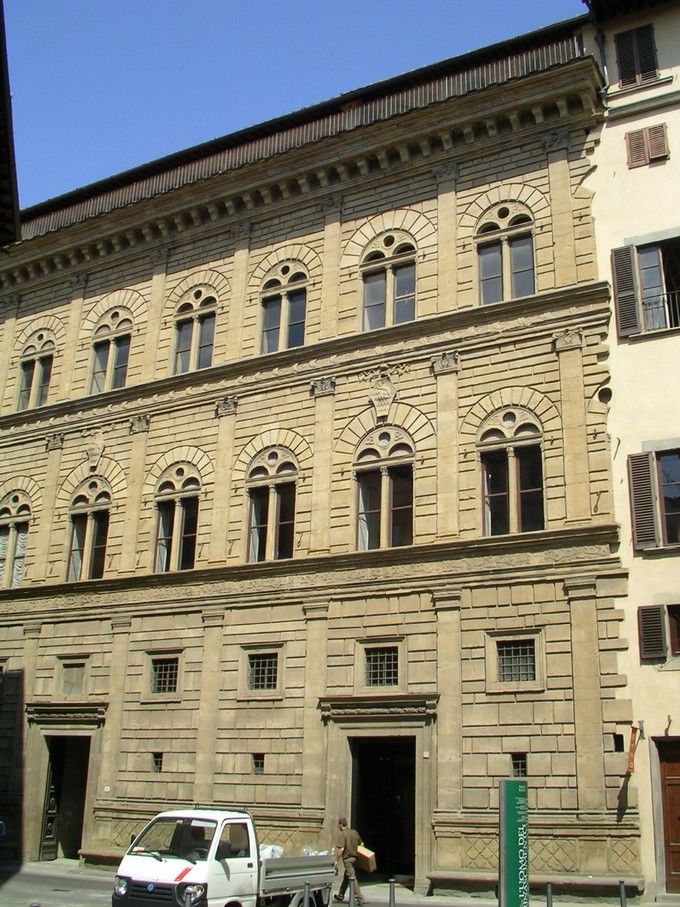
The buildings of the early on Renaissance in Florence expressed a new sense of light, clarity, and spaciousness that reflected the enlightenment and clarity of mind glorified by the philosophy of Humanism.
The Venetian Painters of the High Renaissance
Giorgione, Titian, and Veronese were the preeminent Venetian painters of the High Renaissance.
- The Venetian High Renaissance artists Giorgione, Titian, and Veronese employed novel techniques of color, scale, and composition, which established them as acclaimed artists n of Rome.
- In particular, these three painters followed the Venetian School 's preference of color (colorito) over disegno.
- Giorgio Barbarelli da Castlefranco, known as Giorgione (c. 1477–1510), is an artist who had considerable impact on the Venetian High Renaissance. Giorgione was the commencement to paint with oil on canvas.
- Tiziano Vecelli, or Titian (1490–1576), was arguably the most important member of the Venetian school, as well as one of the most versatile. His use of color would have a profound influence non merely on painters of the Italian Renaissance, but on hereafter generations in Western art.
- Paolo Veronese (1528–1588) was one of the primary Renaissance painters in Venice, known for his paintings such as The Wedding at Cana and The Banquet in the House of Levi.
- disegno: Cartoon or blueprint, linear way.
- colorito: colour and painterly brushwork.
- Venetian School: The distinctive, thriving, and influential art scene in Venice, Italia, starting from the late 15th century.
Giorgione, Titian, and Veronese were the preeminent painters of the Venetian Loftier Renaissance. All three similarly employed novel techniques of colour and composition, which established them as acclaimed artists n of Rome. In particular, Giorgione, Titian, and Veronese follows the Venetian School'due south preference of colour over disegno.
Giorgione
Giorgio Barbarelli da Castlefranco, known as Giorgione (c. 1477–1510), is an creative person who had considerable touch on the Venetian High Renaissance. Unfortunately, art historians practice not know much about Giorgione, partly because of his early death at around historic period xxx, and partly because artists in Venice were not as individualistic as artists in Florence. While just 6 paintings are accredited to him, they demonstrate his importance in the history of fine art as well equally his innovations in painting.
Giorgione was the first to paint with oil on canvass. Previously, people who used oils were painting on panel, not canvas. His works do not contain much under-drawing, demonstrating how he did not adhere to Florentine disegno, and his discipline matters remain elusive and mysterious. Ane of his works that demonstrates all iii of these elements is The Tempest (c. 1505–1510). This work is oil on canvas, x-rays testify there is very picayune under drawing, and the field of study thing remains one of the virtually debated issues in art history.
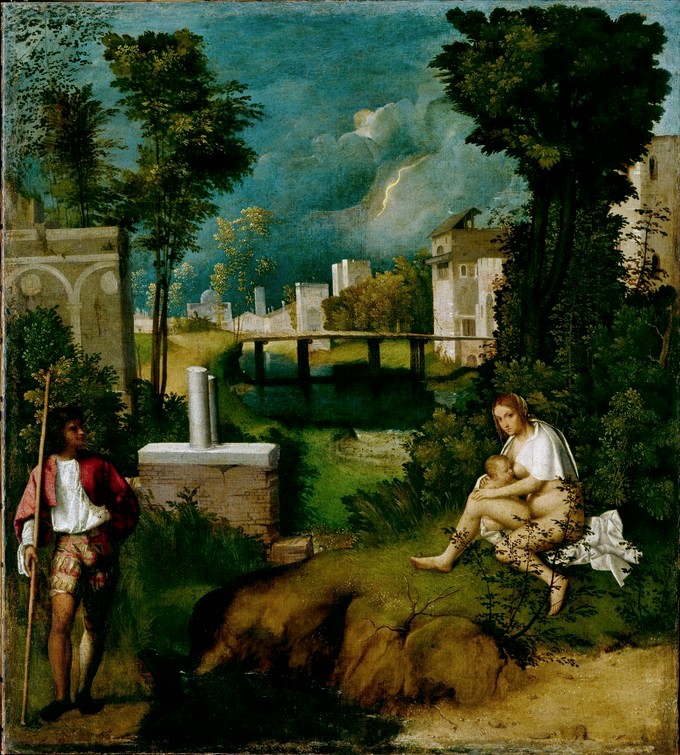
Titian
Tiziano Vecelli, or Titian (1490–1576), was arguably the well-nigh important member of the 16th century Venetian schoolhouse, likewise as one of the nearly versatile; he was equally adept with portraits, landscape backgrounds, and mythological and religious subjects. His painting methods, especially in the application and use of color, would take a profound influence not only on painters of the Italian Renaissance, but on time to come generations of Western art. Over the class of his long life Titian's artistic way changed drastically, just he retained a lifelong interest in color. Although his mature works may non comprise the vivid, luminous tints of his early pieces, their loose brushwork and subtlety of polychromatic modulations were without precedent.
In 1516, Titian completed his well-known masterpiece, the Supposition of the Virgin, or the Assunta, for the high altar of the church of the Frari. This extraordinary piece of colorism, executed on a grand scale rarely before seen in Italy, created a sensation. The pictorial structure of the Supposition—uniting in the aforementioned composition two or 3 scenes superimposed on unlike levels, earth and heaven, the temporal and the infinite.
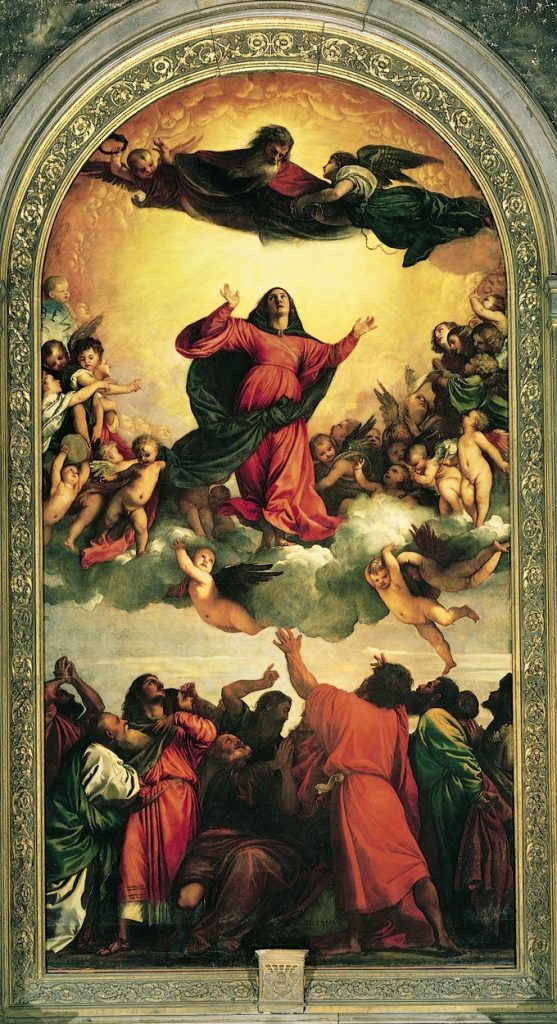
Veronese
Paolo Veronese (1528–1588) was i of the primary Renaissance painters in Venice, well known for paintings such as The Wedding at Cana and The Banquet in the House of Levi. Veronese is known as a supreme colorist, and for his illusionistic decorations in both fresco and oil. His most famous works are elaborate narrative cycles, executed in the dramatic and colorful style, full of majestic architectural settings and glittering pageantry.
His large paintings of biblical feasts executed for the refectories of monasteries in Venice and Verona are especially notable. For example, in The Nuptials at Cana, which was painted in 1562–1563 in collaboration with Palladio, Veronese bundled the compages to run by and large parallel to the picture plane, accentuating the processional graphic symbol of the composition. The artist'south decorative genius was to recognize that dramatic perspective effects would have been wearisome in a living room or chapel, and that the narrative of the moving picture could all-time be absorbed equally a colorful diversion.
The Banquet in the House of Levi was originally meant as a Last Supper. The Counter- Reformation church building found it non to display the proper decorum and chosen Veronese before the Inquisition. Rather than repaint his masterpiece, Veronese changed the name to a story that put Christ in the colorful company of ordinary people. Christ would say when questioned about why he would want to rub shoulders with such rabble that he wasn't needed by the already converted. The Inquisition couldn't argue with that.
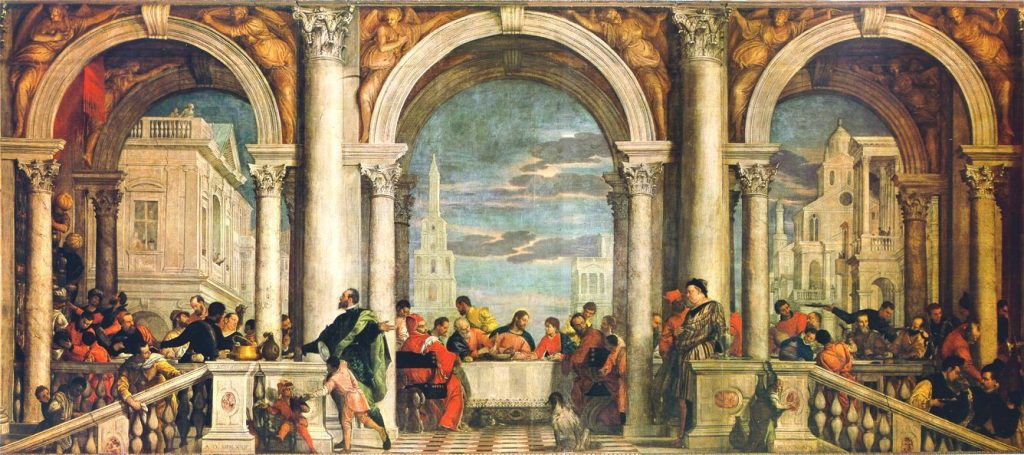
Source: https://boisestate.pressbooks.pub/arthistory/chapter/high-renaissance/
0 Response to "How Was Being an Art in the Renaissance Financed"
Post a Comment